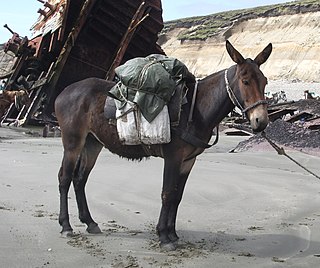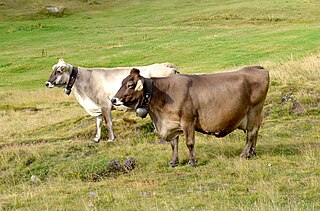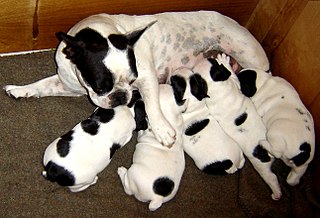Related Research Articles

Genetics is the study of genes, genetic variation, and heredity in organisms. It is an important branch in biology because heredity is vital to organisms' evolution. Gregor Mendel, a Moravian Augustinian friar working in the 19th century in Brno, was the first to study genetics scientifically. Mendel studied "trait inheritance", patterns in the way traits are handed down from parents to offspring over time. He observed that organisms inherit traits by way of discrete "units of inheritance". This term, still used today, is a somewhat ambiguous definition of what is referred to as a gene.

Heredity, also called inheritance or biological inheritance, is the passing on of traits from parents to their offspring; either through asexual reproduction or sexual reproduction, the offspring cells or organisms acquire the genetic information of their parents. Through heredity, variations between individuals can accumulate and cause species to evolve by natural selection. The study of heredity in biology is genetics.

Mendelian inheritance is a type of biological inheritance following the principles originally proposed by Gregor Mendel in 1865 and 1866, re-discovered in 1900 by Hugo de Vries and Carl Correns, and later popularized by William Bateson. These principles were initially controversial. When Mendel's theories were integrated with the Boveri–Sutton chromosome theory of inheritance by Thomas Hunt Morgan in 1915, they became the core of classical genetics. Ronald Fisher combined these ideas with the theory of natural selection in his 1930 book The Genetical Theory of Natural Selection, putting evolution onto a mathematical footing and forming the basis for population genetics within the modern evolutionary synthesis.

In biology, a hybrid is the offspring resulting from combining the qualities of two organisms of different varieties, species or genera through sexual reproduction. Generally, it means that each cell has genetic material from two different organisms, whereas an individual where some cells are derived from a different organism is called a chimera. Hybrids are not always intermediates between their parents, but can show hybrid vigor, sometimes growing larger or taller than either parent. The concept of a hybrid is interpreted differently in animal and plant breeding, where there is interest in the individual parentage. In genetics, attention is focused on the numbers of chromosomes. In taxonomy, a key question is how closely related the parent species are.

A breed is a specific group of domestic animals having homogeneous appearance (phenotype), homogeneous behavior, and/or other characteristics that distinguish it from other organisms of the same species. In literature, there exist several slightly deviating definitions. Breeds are formed through genetic isolation and either natural adaptation to the environment or selective breeding, or a combination of the two. Despite the centrality of the idea of "breeds" to animal husbandry and agriculture, no single, scientifically accepted definition of the term exists. A breed is therefore not an objective or biologically verifiable classification but is instead a term of art amongst groups of breeders who share a consensus around what qualities make some members of a given species members of a nameable subset.

Genetic variation is the difference in DNA among individuals or the differences between populations among the same species. The multiple sources of genetic variation include mutation and genetic recombination. Mutations are the ultimate sources of genetic variation, but other mechanisms, such as genetic drift, contribute to it, as well.

Dog breeding is the practice of mating selected dogs with the intention of maintaining or producing specific qualities and characteristics. When dogs reproduce without such human intervention, their offspring's characteristics are determined by natural selection, while "dog breeding" refers specifically to the artificial selection of dogs, in which dogs are intentionally bred by their owners. Breeding relies on the science of genetics, hence a breeder who is knowledgeable on canine genetics, health, and the intended purpose of the dogs attempts to breed suitable dogs.
A crossbreed is an organism with purebred parents of two different breeds, varieties, or populations. Crossbreeding, sometimes called "designer crossbreeding", is the process of breeding such an organism. While crossbreeding is used to maintain health and viability of organisms, irresponsible crossbreeding can also produce organisms of inferior quality or dilute a purebred gene pool to the point of extinction of a given breed of organism.

The domestication of vertebrates is the mutual relationship between vertebrate animals including birds and mammals, and the humans who have influence on their care and reproduction.
Inbreeding depression is the reduced biological fitness that has the potential to result from inbreeding. Biological fitness refers to an organism's ability to survive and perpetuate its genetic material. Inbreeding depression is often the result of a population bottleneck. In general, the higher the genetic variation or gene pool within a breeding population, the less likely it is to suffer from inbreeding depression, though inbreeding and outbreeding depression can simultaneously occur.
Chondrodystrophy refers to a skeletal disorder caused by one of myriad genetic mutations that can affect the development of cartilage. As a very general term, it is only used in the medical literature when a more precise description of the condition is unavailable.
Under the law of dominance in genetics, an individual expressing a dominant phenotype could contain either two copies of the dominant allele or one copy of each dominant and recessive allele. By performing a test cross, one can determine whether the individual is heterozygous or homozygous dominant.
Telegony is a theory of heredity holding that offspring can inherit the characteristics of a previous mate of the female parent; thus the child of a woman might partake of traits of a previous sexual partner. Experiments in the late 19th century on several species failed to provide evidence that offspring would inherit any character from their mother's previous mates. It was superseded by the rediscovery of Mendelian inheritance and the Boveri–Sutton chromosome theory.
Out-crossing or out-breeding is the technique of crossing between different breeds. This is the practice of introducing distantly related genetic material into a breeding line, thereby increasing genetic diversity.

The genetic basis of coat colour in the Labrador Retriever has been found to depend on several distinct genes. The interplay among these genes is used as an example of epistasis.

The popular sire effect occurs when an animal with desirable attributes is bred repeatedly. In dog breeding, a male dog that wins respected competitions becomes highly sought after, as breeders believe the sire possesses the genes necessary to produce champions. However, the popular sire effect is not just down to wanting to produce a champion. For example, in Staffordshire Bull Terriers there are several popular sires who are used by breeders to produce specific colours that are not favoured in the show ring. The popular sire is often bred extensively with many females. This can cause undetected, undesirable genetic traits in the stud to spread rapidly within the gene pool. It can also reduce genetic diversity by the exclusion of other males.
This article considers the history of zoology since the theory of evolution by natural selection proposed by Charles Darwin in 1859.
Classical genetics is the branch of genetics based solely on visible results of reproductive acts. It is the oldest discipline in the field of genetics, going back to the experiments on Mendelian inheritance by Gregor Mendel who made it possible to identify the basic mechanisms of heredity. Subsequently, these mechanisms have been studied and explained at the molecular level.
This glossary of genetics and evolutionary biology is a list of definitions of terms and concepts used in the study of genetics and evolutionary biology, as well as sub-disciplines and related fields, with an emphasis on classical genetics, quantitative genetics, population biology, phylogenetics, speciation, and systematics. Overlapping and related terms can be found in Glossary of cellular and molecular biology, Glossary of ecology, and Glossary of biology.
References
- ↑ McFadden, Johnjoe; Al-Khalili, Jim (2014). Life on the Edge : The Coming of Age of Quantum Biology (1st ed.). New York. p. 210. ISBN 978-0-307-98681-8. OCLC 914329162.
{{cite book}}: CS1 maint: location missing publisher (link) - 1 2 3 4 Gidney, Louisa (May–June 2007). "Earliest Archaeological Evidence of the Ancon Mutation in Sheep from Leicester, UK". International Journal of Osteoarchaeology. 17 (3): 318–321. doi:10.1002/oa.872. ISSN 1099-1212.
- ↑ Shelton, Maurice (1968). "A recurrence of the Ancon dwarf in Merino sheep". Journal of Heredity. 59 (5): 267–268. doi:10.1093/oxfordjournals.jhered.a107714. PMID 5753237.
- ↑ Chang, T. K. (1949). "Crippling in chondrodystrophic (Ancon) sheep". Growth. 13 (3): 299–307. PMID 18142372.
- ↑ Schwartz, Karlene; Vogel, Jane (Dec 1994). "Unraveling the Yarn of the Ancon Sheep" . BioScience. Oxford University Press. 44 (11): 764–768. doi:10.2307/1312585. ISSN 0006-3568. JSTOR 1312585 . Retrieved 2014-07-03.
Ancon sheep are important to the history of biology because Charles Darwin used them to support his argument that animals inherit parental traits without blending: "When turnspit dogs and Ancon sheep, both of which have dwarfed limbs, are crossed with common breeds, the offspring are not intermediate in structure, but take after either parent." Before Darwin's day, many plant and animal breeders assumed that parental traits would mingle in the offspring.
- ↑ Schwartz, Jeffrey (January 13–16, 2005). "A Cultural History of Heredity III: 19th and Early 20th Centuries" (PDF). Darwinism versus Evo–Devo: a late–nineteenth century debate. A Cultural History of Heredity III: 19th and Early 20th Centuries. Max Planck Institute for the History of Science. pp. 67–84. Retrieved 7 March 2013.
- ↑ Eigenmann, C.H. (1895). "The Study of Variation". Proceedings of the Indiana Academy of Science. 5: 265–278. Retrieved 2014-03-07.